 PathScribe Panel
PathScribe Panel
The PathScribe panel allows you to numerically edit anchor points and their handles, as well as perform certain operations on one or more points or paths. Its flyout menu also allows you to select handles and points, perform certain path operations, change the layout of the panel, and bring up the Preferences dialog. The panel has two different appearances depending on whether multiple handles are selected. You can show or hide the PathScribe panel using the menu command Window > Astute Graphics > PathScribe.
Point Mode
When no handles are selected, the panel appears in Point Mode:

PathScribe Panel point mode
1. Flyout menu
See PathScribe Panel: Flyout Menu.
2. Panel banner
The help button on the right opens the help documentation in the Astute Manager. If this does not automatically appear, please ensure your Astute Manager is running first.
Click on the other area of the color bar to activate the PathScribe tool. This is a quick method of locating the tool within the default Advanced toolbar or a custom toolbar.
3. Status Line
Shows information about the current selection, for example “7 points selected”. When exactly two anchor points are selected, the status line shows the distance between them, and displays a small button which allows you to average the points’ positions, to make them coincident:

PathScribe Panel two point average
Option/Alt-clicking on the status line when showing the distance between two points will copy the distance value to the system clipboard.
If the third row of buttons is hidden, the status line also contains a redundant point indicator/button (see below). Finally, the status line will also indicate what you are editing during a drag operation.
4. Point and Path Buttons (row 1)
a. Connector Point Recognition Button: Toggles Connector Point recognition. When the “C” symbol is dim, connector point recognition is off and the PathScribe tool will not afford any special handling to points which qualify as connectors.
b. Smooth Point Button: Changes all selected anchor points to smooth points. By default, this also adds new handles to these points so they all have two opposed handles. This can be very useful for creating a path that runs smoothly through the points:

PathScribe smooth point button example
The algorithm that PathScribe uses to create new handles is as follows: If a point already has one handle, its second handle is created by mirroring the existing handle. If a point has no handles, the new handle angle is calculated by bisecting the angle formed by the previous point, the point in question, and the next point, and taking its perpendicular. The new handle length is calculated by taking the lesser of the distances from the point in question to the previous and next points, and multiplying by the smoothing ratio (set in the Preferences dialog). Handles of endpoints of open paths, if created, are adjusted to aim towards the next/previous handle.
To change selected anchor points to smooth points without adding handles, hold down Option/Alt when clicking the button.
c. Corner Point Button: Changes all selected anchor points to corner points. No handles are created or changed.
d. Split Path Button: Splits the path(s) at the selected points, just as clicking on them with the Scissors tool would. Both new endpoints get a copy of the original point’s handles.
e. Smart Remove Point Button: Removes the selected point(s) from the path while attempting to keep the curve as close as possible to its original shape. This is achieved by adjusting the lengths (but not angles) of the handles on either side of the removed points. To remove points without handle adjustment in the manner of the Delete Anchor Point tool, hold down Option/Alt while clicking the button.
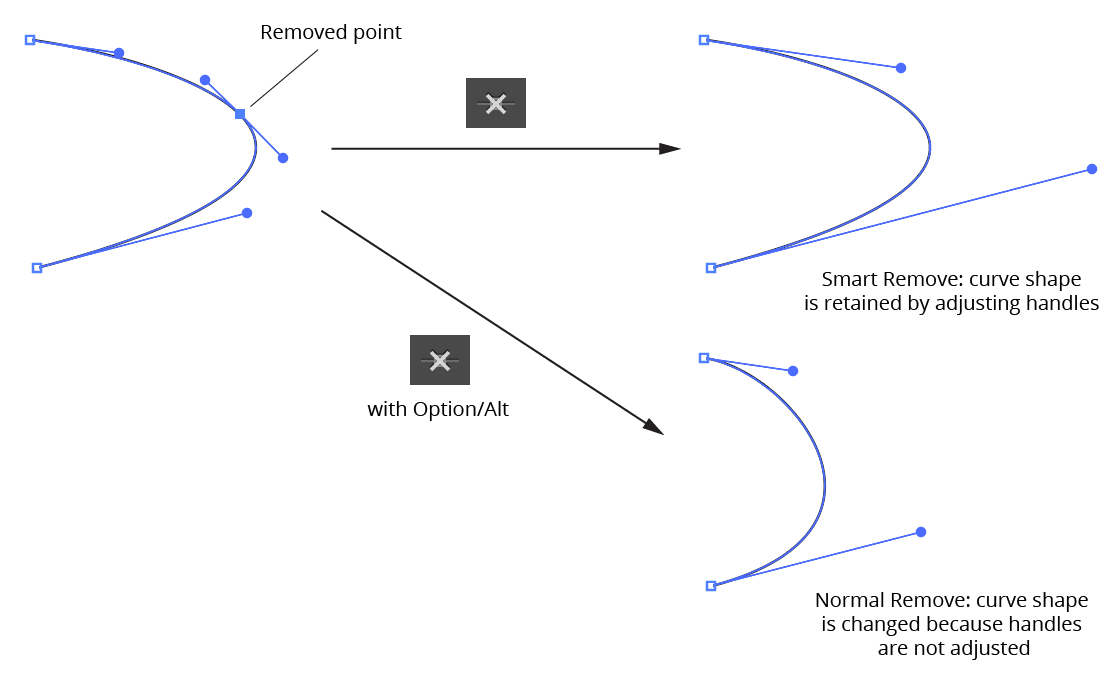
PathScribe Panel smart point remove
When anchor points are selected, you can use the keypress assigned in the Keyboard Shortcuts dialog for “Increase Diameter” (by default, the right bracket key – ]) as a shortcut for the Smart Remove Point button.
When Shift is held down while the button is clicked, PathScribe removes straight segment corners. To utilize this function, two or more adjacent anchor points must be selected, the first and last of which are adjacent to a straight segment (or at the end of an open path); the segments do not necessarily have to form a “nice” corner. The selected anchor points are replaced by a single anchor point at the intersection of the outer straight segments:
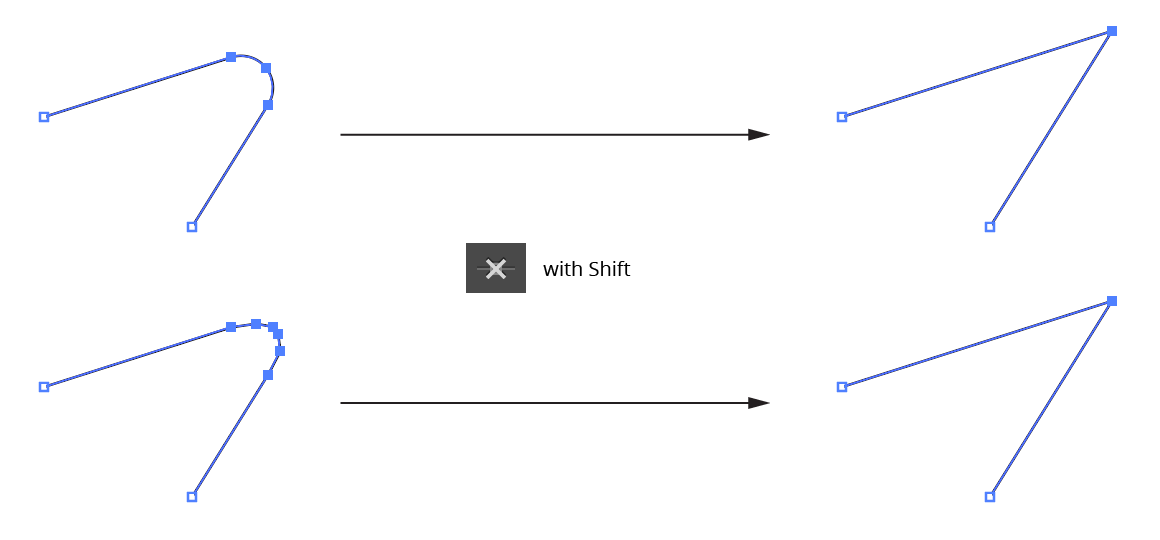
PathScribe removes handles
5. Point and Path Buttons (row 2)
a. Retract Handles Button: Retracts all of the handles on the selected point(s). Point types are not changed. Holding down Option/Alt while clicking the button activates an alternate function: it swaps the positions of the in and out handles on each selected point.
b. Retract Segment Handles Button: Retracts handles from all selected path segments. Point types are not changed.

PathScribe Panel remove handles from segments
c. Show Handles Button: All paths or compound path subpaths which are at least partly selected will have all handles made visible (note that this deselects all anchor points and instead selects all path segments).
d. Select Path Points Button: Selects all points on all paths which are at least partially selected.
e. Select All Handles Button: Selects all handles on all paths which are at least partially selected; PathScribe then enters Multi-Handle mode.
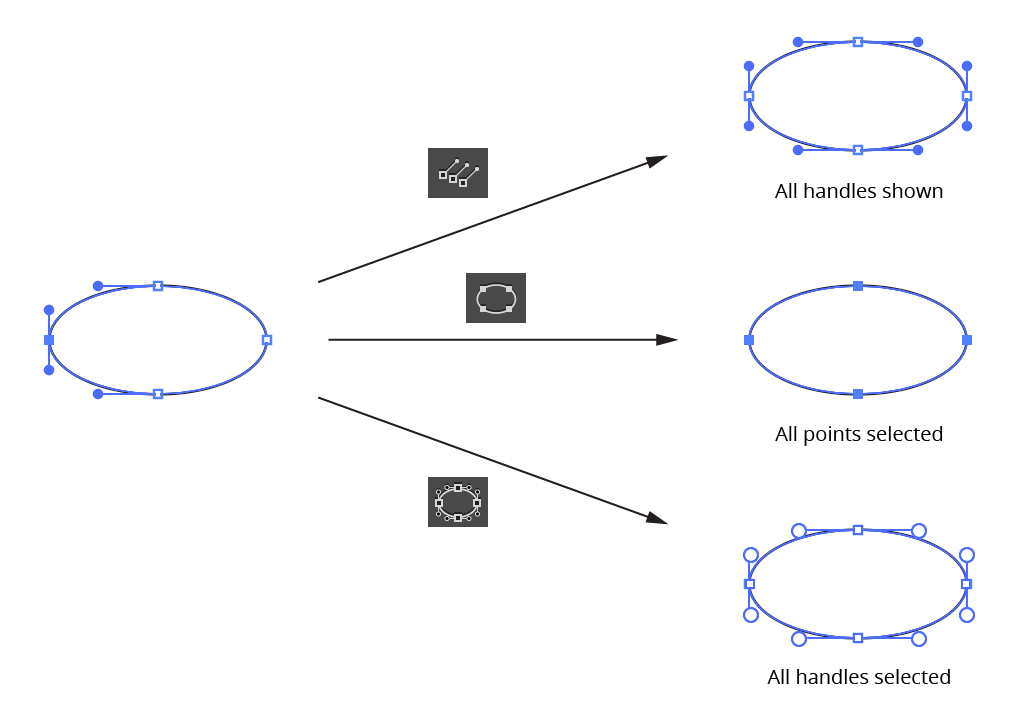
PathScribe second row icons
6. Point and Path Buttons (row 3)
This row can be shown or hidden using the PathScribe panel flyout menu.
a. Smart Smooth Button: Enables or disables “Smart Smooth”, a feature of the PathScribe tool which allows you to convert a corner point into a smooth point simply by dragging one of the point’s handles to be opposite the other (within a certain tolerance). A small red “S” annotation is drawn over points which are being aligned this way. The threshold angle value can be specified in the Preferences dialog.

PathScribe panel smart smooth
b. Reverse Path Direction Button: Reverses the direction of any selected paths or subpaths. This will generally only produce a visible change to the artwork if a subpath of a filled compound path is reversed or if the path is being stroked by an asymmetric brush:
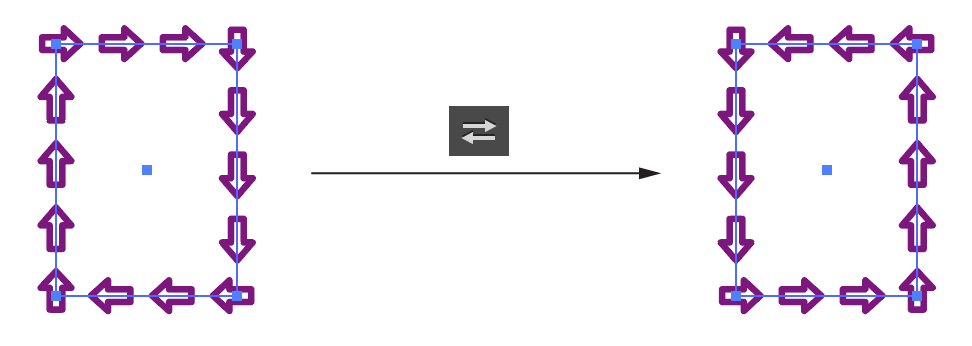
PathScribe Reverse Path Direction Button
When the third row of buttons is hidden, the “Reverse Path” command can still be accessed through the PathScribe panel flyout menu (see below).
c. Add Points to Selected Segments Button: Adds anchors points to every selected segment of every selected path. The number of points added and algorithm used to add them are taken from the last-used settings. To open the dialog which enables you to edit these values, Option/Alt-click on the button.

PathScribe Add Points to Selected Segments Button
When the third row of buttons is hidden, the “Add Points” command can still be accessed through the PathScribe panel flyout menu (see below).
d. Move Points to Tangencies Button: Moves anchor points on the selected paths to positions along the path where the angle of the path as it passes through the anchor point is tangent to the horizontal or vertical axes (taking into account the current constrain angle).

PathScribe Move Points to Tangencies Button
Holding down Option/Alt when clicking the button changes its functionality: new anchor points are placed at the tangent positions, but the existing anchor points are retained.
Holding down Shift when clicking the button also changes its functionality: Only selected points are moved to tangencies.
When the third row of buttons is hidden, the “Move Points” command can still be accessed through the PathScribe panel flyout menu (see below).
e. Remove Redundant Points Button: Removes all redundant points from all selected paths. If the button is disabled (dim), no redundant points exist. A redundant point, also known as a doubled point, is defined as the latter of two consecutive anchor points on a path that have exactly the same X and Y coordinates and don’t have handles in the (zero-length) segment between them. They are often created after using the PathFinder functions or after using Object > Path > Outline Stroke, and despite not changing the shape of the path, can cause problems when performing additional functions such as offsetting. You can highlight the locations of redundant points when using the PathScribe tool by enabling the corresponding preference (see PathScribe Preferences).
When the third row of buttons is hidden, the button will appear on the right side of the top status line. Due to space considerations, the icon uses a small exclamation point rather than the full icon:

PathScribe Remove Redundant Points Button
7. Numeric Value Fields
This area can be shown or hidden using the PathScribe panel flyout menu.

PathScribe Numeric Value Fields
When an anchor point is selected, the numeric value fields becomes active, reflecting the X and Y coordinates of the anchor point and the coordinates, lengths and angles of its two direction handles. You can make edits to any of the fields by simply typing in a new value and pressing Return/Enter or Tab. Like other numerical entry fields in Illustrator, you can use any units you wish (except in the angle fields) and one math operator.
The linked handles icon appears when editing a smooth point, as a reminder that edits to the coordinates or angle of one handle will also affect the other handle (if it exists).
You can specify the number of digits that are displayed after the decimal point through PathScribe’s Precision preference.
When more than one anchor point is selected, fields which are blank indicate that multiple values are present. You can still type a new value into the field, thereby assigning it to all selected anchor points/ handles. Or, for the anchor point fields, you can Shift-click on the anchor point icon to average all values in both fields; or Shift-click on the “X:” or “Y:” labels to average only the corresponding value.
When the Show Anchor Point Coordinate Ranges preference is enabled, mixed values will be instead displayed in the anchor point coordinate fields as a value (in blue) representing the difference between the highest value and the lowest value:

PathScribe Coordinates of points
Clicking on the range will allow you to enter a new value, just as with the preference disabled. Values which are too small to display with the current precision are displayed using scientific notation, e.g. 3.12E-06, where “E-06” means “×10–6” (one-millionth).
8. Path Control Area
This area can be shown or hidden using the PathScribe panel flyout menu. In Point Mode, the path control area has three different appearances:
a. When the selection consists of more than one path, the path control area shows the total number of selected paths and the number of each type (closed, open, or single-point). Each subpath of a compound path is reported separately.

PathScribe Panel Path Control Area multiple paths
b. When the selection consists of a single path, and either multiple points or no points on the path are selected, the status line shows the type of path and a Select Point 0 button. Because Illustrator numbers points starting at zero and continuing consecutively in the direction of the path, clicking the button will therefore select the first point on the path. By default, the selected point will be briefly highlighted with a small magenta dot to make it easier to locate. If the Highlight Panel-Selected Points preference is disabled, you can still highlight the point on a use-by-use basis by holding down Option/Alt when clicking the button.
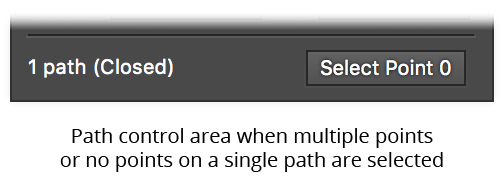
PathScribe Panel Point Control Area Show Point
c. When the selection consists of a single point on a single path, the path control area shows the index of the point, the range of indices on the path, and two buttons that let you change the point that is selected. To move to (i.e., select) the previous or next point on the path, click the Previous point or Next point button. Clicking the Next point button or Previous point button while the last point of an open path is selected will wrap around to the other end.
Holding down Shift while clicking the Next point or Previous point buttons will move ahead or back 10 anchor points (if the path has more than 10 points).

PathScribe PCA Previous Next buttons
Again, the selected point will be briefly highlighted by default.
Multi-Handle Mode
If one or more handles are selected, the panel switches to Multi-Handle Mode:
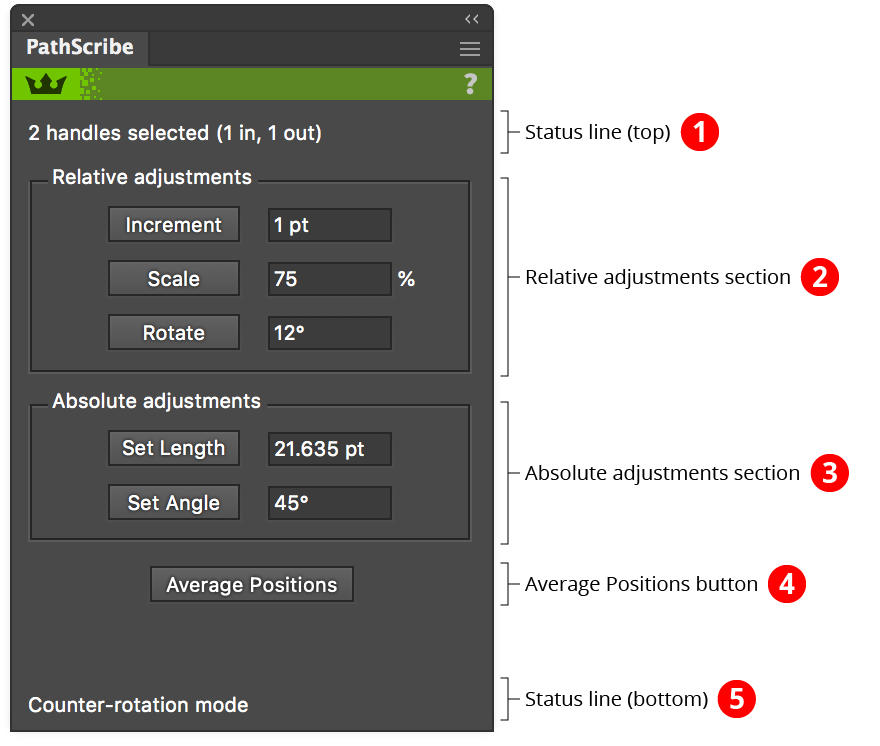
PathScribe Multi-Handle Mode
1. Status Line (top)
In Multi-Handle Mode, the top status line will tell you how many handles you have selected, and how many are of each type (in and out).
2. Relative Adjustments Section
The relative adjustment buttons (Increment, Scale, and Rotate) transform selected handles relative to their current lengths and/or angles. The values you enter are retained from use to use. You can either enter a value and click on the button next to it, or enter a value and type Return/ Enter . If you click the button, you can simultaneously hold down Shift to multiply the effect of the transformation by the shift multiplier, which is set in the preferences. You can also hold down the Option/Alt key to reverse the effect of the transformation.
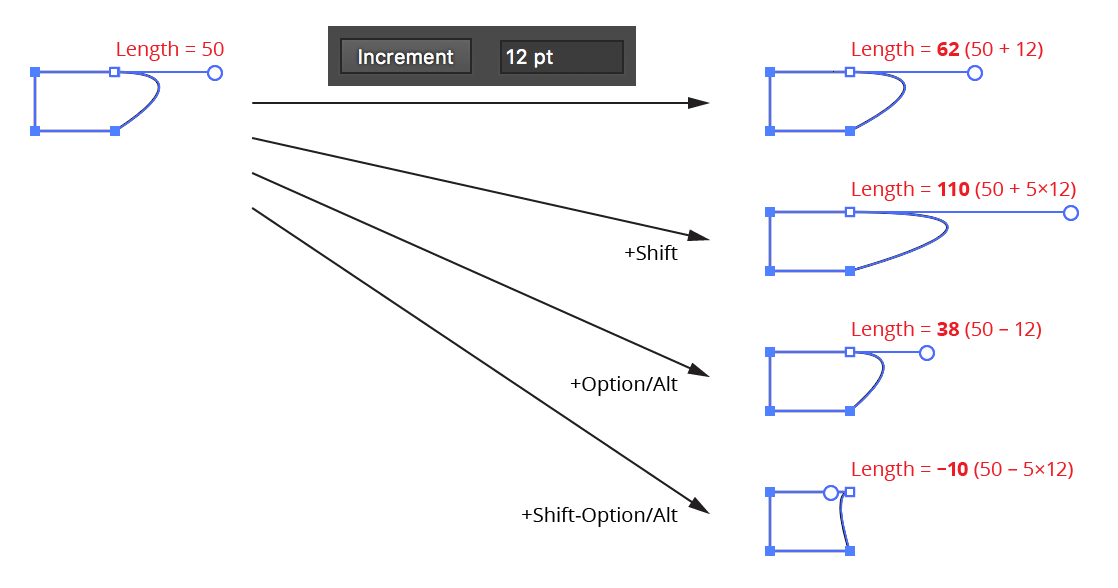
PathScribe Panel Mutlihandle Increment
When using Option/Alt with the Scale button, the reciprocal of the scale value is used (e.g. if a handle is scaled 80%, Option/Alt will change the scale to (1/0.80) = 1.35 = 125%).
3. Absolute Adjustments Section
The absolute adjustment buttons (Set Length and Set Angle) transform handles using the values in the fields adjacent to them. As with relative adjustments, the Shift and Option/Alt keys can be held while clicking the buttons to scale or invert the transformation. However, the keys have a slightly different meaning with the Set Angle button: Shift + Set Angle reflects the handle across the horizontal axis passing through the point; Option/Alt + Set Angle reflects the handle across the vertical axis. Shift+Option/Alt + Set Angle reflects the handle across both axes (which is the same as rotating it 180°).
When a single handle is selected, its length and angle values are copied into the value fields of the absolute adjustments section. This enables you to easily “pick up” a handle’s attributes and copy it to one or more other handles. To do this, select only the handle whose attribute(s) you wish to copy. Then, holding down Shift, marquee-select the other handles and click the appropriate buttons to duplicate either the length or angle:

PathScribe Panel handle length copying
You can also hold down the Command/Ctrl key when clicking the Set Length button to change the length to zero (retract the handles). Or, even easier, use the keypress assigned in the Keyboard Shortcuts dialog for “Increase Diameter” (by default, the right bracket key – ]).
4. Average Positions Button
The Average Positions button moves all selected handles to the position whose X coordinate is an average of all the selected handle X coordinates and whose Y coordinate is an average of all the selected handle Y coordinates. If the selected handles are already coincident (all at the same position), the button will be disabled.

PathScribe Panel handle averaging
5. Status Line (bottom)
When the mouse button is up, the bottom status line that tells you which multi-handle drag mode is active. When the mouse button is down, it gives information about the current operation and any keypresses which can affect it. Also, when you are constraining multiple handles (by holding down the Option/Alt key while dragging), the bottom status line will indicate whether you are using the proportional method of handle extension or the absolute method.
PathScribe Panel Flyout Menu
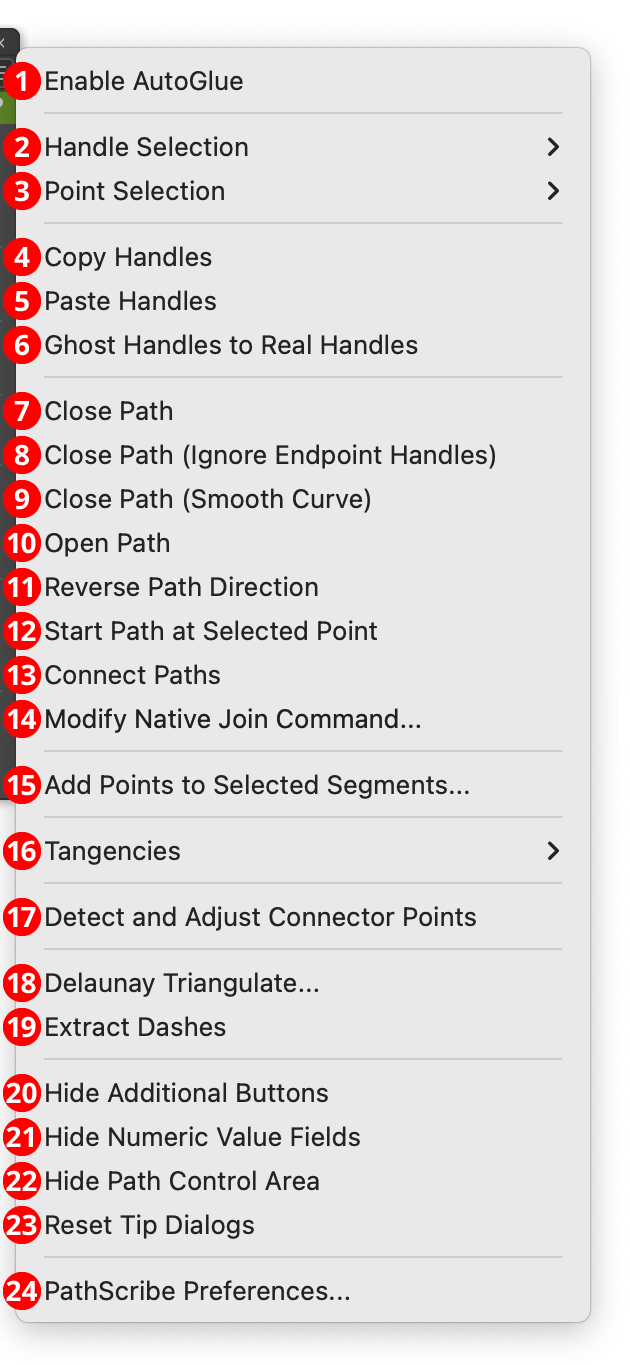
PathScribe Panel Flyout Menu
The PathScribe panel flyout menu and related submenus are shown here with all items enabled; in actual use, items which are not applicable in the current context would be disabled. Additionally, some of the menu items may change their wording slightly depending on context. For example, the Hide Additional Buttons menu item will say Show Additional Buttons if the buttons are already hidden.
1. Enable/Disable AutoGlue
AutoGlue is a feature of the PathScribe tool that enables anchor points (and/or handles) that lie directly on top of each other to be treated as if they were temporarily “glued” together, thereby allowing them to be moved together even if they aren’t all selected. The feature is disabled by default. When first enabled, a tip dialog with a short summary will be displayed.
Normally, dragging an anchor point without marquee-selecting multiple points will only affect the topmost path, even if other anchor points sit at the same position:

PathScribe Example Without AutoGlue Enabled
But when AutoGlue is enabled, all anchor points with the same coordinates will act as though they were “glued” together, and will move as one:

PathScribe Example With AutoGlue Enabled
AutoGlue also works on entire path segments: if two paths share a segment (both the anchor points at each end and their inward-facing handles, if any, all lie on top of each other), then editing the path segment (reshaping, dragging out or converting ghost handles, and adding or deleting points) with AutoGlue enabled will simultaneously edit the “glued” segments:

PathScribe AutoGlue Example Reshaping Segments
AutoGlue is especially useful when working with artwork created with generative AI, since this type of art is often composed of non-overlapping paths with common edges. A tolerance value, used to determine whether coordinates are considered identical, is specifiable in the PathScribe preferences.
2. Handle Selection submenu
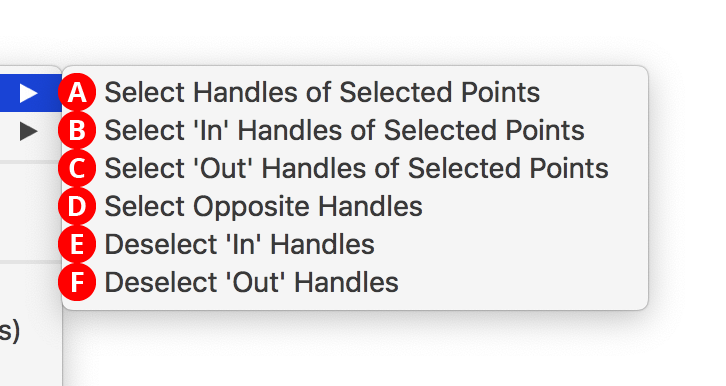
PathScribe Panel Flyout submenu
A. Select Handles of Selected Points
When there are one or more points selected, selects all of the handles on all of the selected points and enters Multi-Handle mode. The PathScribe tool will automatically be selected afterwards if it is not already so you can work with the selected handles.
Shift+Option/Alt-clicking on an empty area of the canvas with the PathScribe tool does the same thing as choosing Select Handles of Selected Points but is much easier.
B. Select ‘In’ Handles of Selected Points
C. Select ‘Out’ Handles of Selected Points
Same as A., but only selects handles of the specified type.

Select in and out handles PathScribe
D. Select Opposite Handles
[Enabled only in Multi-Handle mode] Selects an anchor point’s in handle if only the out handle is selected, and its out handles if only the in handle is selected. If both handles were originally selected, they both remain selected.
E. Deselect ‘In’ Handles
F. Deselect ‘Out’ Handles
[Enabled only in Multi-Handle mode] Removes all handles of the specified type from the handle selection.
3. Point Selection submenu
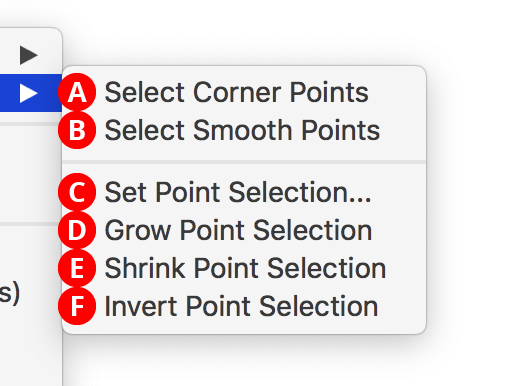
PathScribe point selection submenu
A. Select Corner Points
B. Select Smooth Points
Selects all anchor points of the specified type on all selected paths.
C. Set Point Selection...
Allows you to select points on selected paths by position, using the dialog that comes up:

Point Selection PathScribe Skip Steps
The “Initial Skip” value specifies the number of anchor points to leave unselected, starting at point 0 of the path. Thereafter, the selection pattern is specified by the “Select” and “Skip” values, which specify the number of points in a row to select followed by the number to leave unselected. As the values are changed, the points which will be selected are dynamically highlighted on the artboard using magenta dots:

Point Selection PathScribe Skip Steps
You can bypass the dialog and use the values from the previous application of Set Point Selection by holding down Shift while choosing the menu item. The Reset button changes Initial Skip to 0, Select to 1, and Skip to 1 (i.e., every other point starting with the first). Holding down Shift while clicking the Reset button does the same except the Initial Skip is set to 1.
D. Grow Point Selection
Grows the current point selection by selecting one additional anchor point on either side of all points which are already selected.

PathScribe Grow Point Selection
You can use the keypress assigned in the Keyboard Shortcuts dialog for “Decrease Diameter” (by default, the left bracket key – [) as a shortcut for growing the point selection.
E. Shrink Point Selection
Shrinks the current point selection by deselecting all anchor points which already have an unselected point on either side of them, or are on the end of an open path.
F. Invert Point Selection
Inverts the current point selection by switching unselected anchor points for selected points. Paths which were completely unselected to start remain unselected.
4. Copy Handles
Lets you copy the direction and length of a single handle, or, as long as they are the in and out handles of a single point, two handles. When both handles of a point are copied, the point type (corner or smooth) is also retained. The menu item is available when a single point is selected, or in Multi-Handle mode when one handle or the in and out handles of a single point are selected. The PathScribe tool does not need to be active when copying both handles from a single point. Copied handle and point type data is stored in an internal clipboard which is cleared only when Illustrator is quit.
5. Paste Handles
Lets you change both handles on any selected points (or specific, selected handles when in Multi-Handle mode) to match the handle(s) that were previously copied with Copy Handles. You can paste to multiple points on multiple paths, and the PathScribe tool does not need to be active. If a single handle was copied, then its data will be pasted to any selected handles, regardless of type (in or out), and any affected points will become corner points. If both handles of a single point were previously copied, then selected in handles will receive the copied in handle’s data, and selected out handles will receive the copied out handle’s data. If a point gets two new handles from two handles that were previously copied, then the previously-copied point type (smooth or corner) is also applied to it.
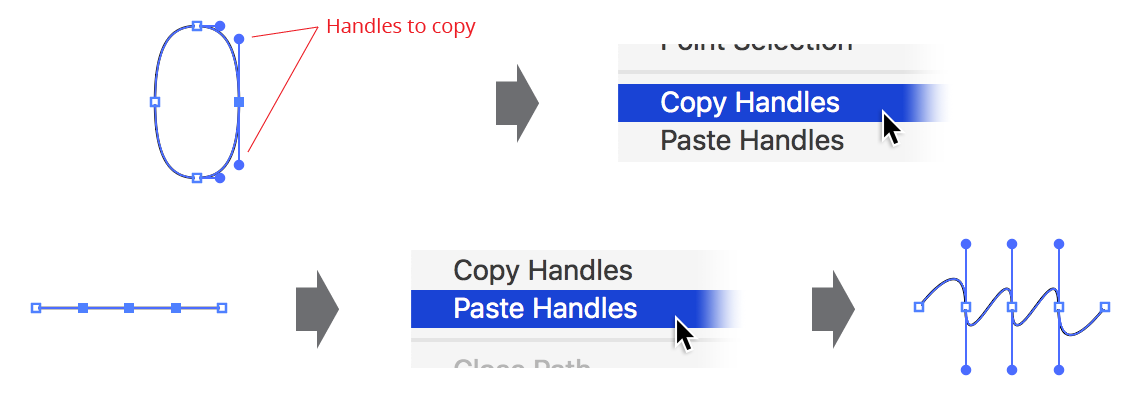
PathScribe copy paste handles
6. Ghost Handles to Real Handles
When one or more ghost handles are visible, converts them to real handles.
7. Close Path
8. Close Path (Ignore Endpoint Handles)
9. Close Path (Smooth Curve)
All these menu items close selected open paths; they differ in how handles for the new segment are created. Close Path honors existing handles; Close Path (Ignore Endpoint Handles) always results in a straight new segment without handles; Close Path (Smooth Curve) creates new handles for the segment such that it blends smoothly with the existing path segments:
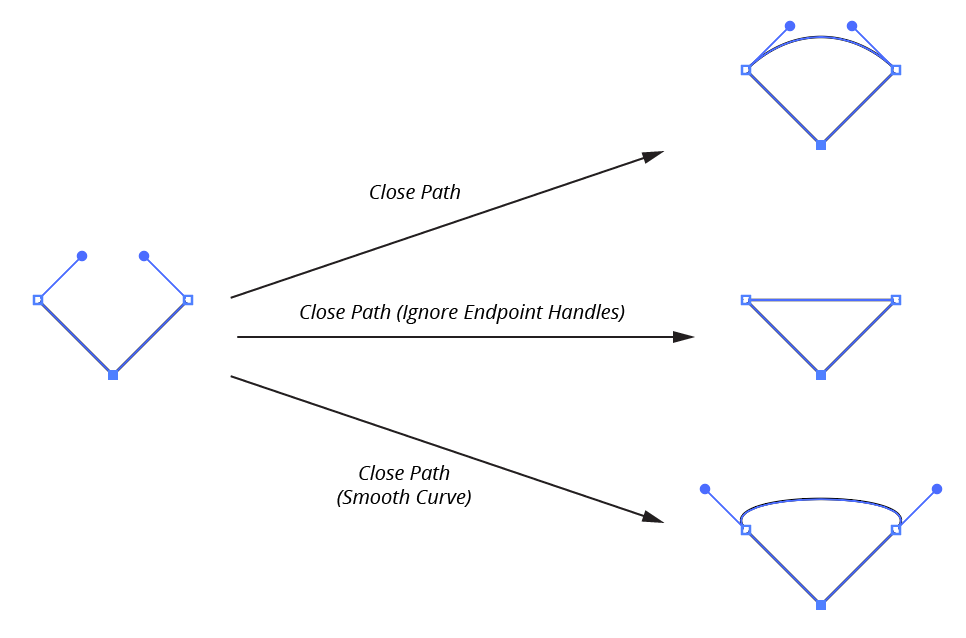
PathScribe Panel Flyout close path
10. Open Path
Converts all selected closed paths into open paths by removing the last segment (point count does not change). This can be useful for fixing paths that are simple two-point lines which have been inadvertently created or imported as closed paths.
11. Reverse Path Direction
Performs the identical function as the Reverse Path Button on the PathScribe panel, but is accessible even when the third row of panel buttons is hidden.
12. Start Path at Selected Point
Available when the selection consists of at least one closed path with exactly one selected point. Forces the closed path to begin at the selected point (it becomes “Point 0”). The change to the path is generally only visible when the path is stroked by a non-uniform brush, or has an arrowhead:

PathScribe Start Path at Selected Point
13. Connect Paths
Available when the selection consists of exactly two open paths, each with a single endpoint selected. Acts similarly to the native Join command, but instead of a straight joining segment, the joining segment will blend smoothly with the existing path segments:
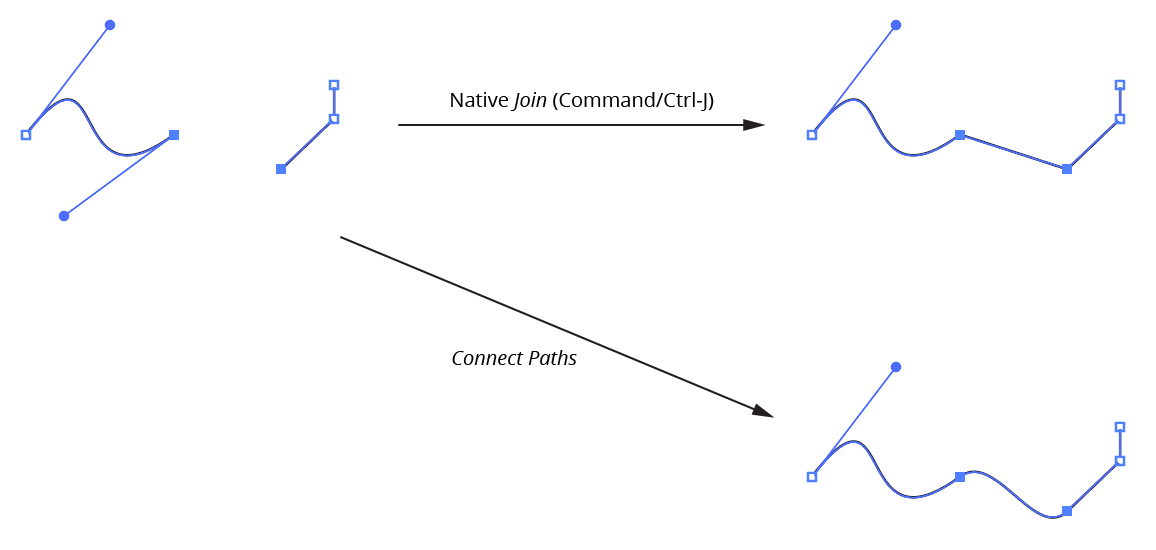
PathScribe Panels Connect Paths
14. Modify Native Join Command…
Allows the native Object > Path > Join menu command (typically called using the shortcut key Command/Ctrl-J) to join the selected paths with smoothly curved segments instead of the default straight segments. Choosing the PathScribe menu item will bring up a small dialog:
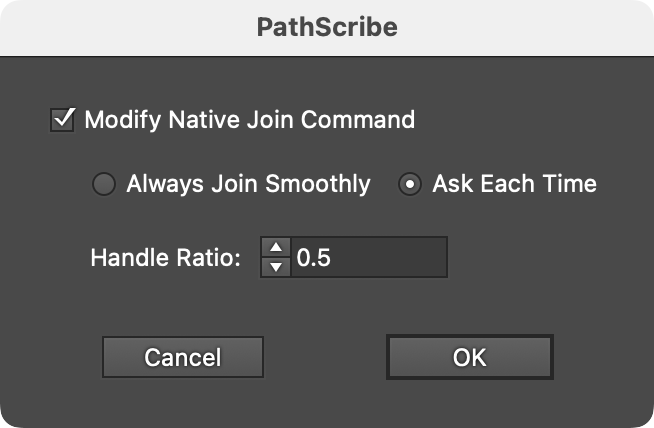
PathScribe Modify Native Join Dialog
Turning on the Modify Native Join Command setting will allow one of two methods to be used:
Always Join Smoothly: Whenever the Join command is used, the paths will automatically be joined smoothly with the originally-specified handle ratio. To join using straight segments, the PathScribe flyout menu item would have to be selected again to turn off or change the setting. Therefore, this setting is best used when you rarely want to join with straight segments, or need to adjust the handle ratio.
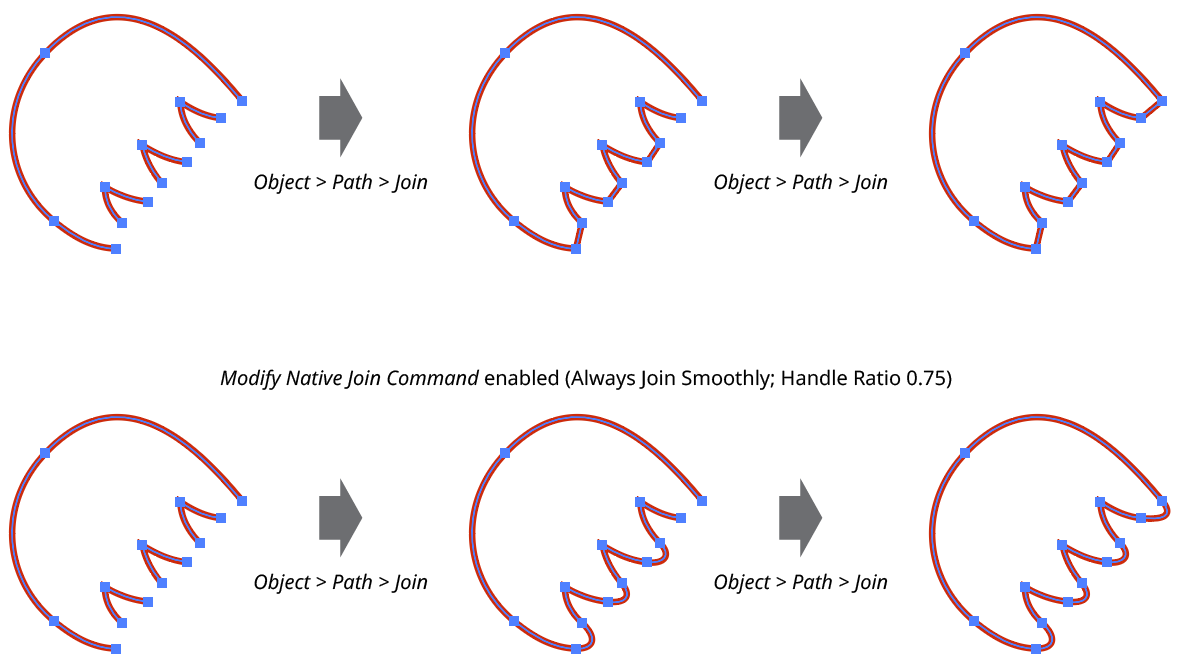
PathScribe Modify Native Join Command Example
Ask Each Time: Whenever the Join command is used, an additional dialog will come up immediately prior to its execution, allowing you to either join in the native way (straight segments), or with smooth curves. If the latter, the Handle Ratio can be changed as well (see below). The Join Type choice affects only that specific instance of the Join command, unless Always Use This Choice is enabled before the dialog is OK’d. In that case, the choice will be remembered and the dialog will not come up again unless the PathScribe flyout menu item is selected once again.
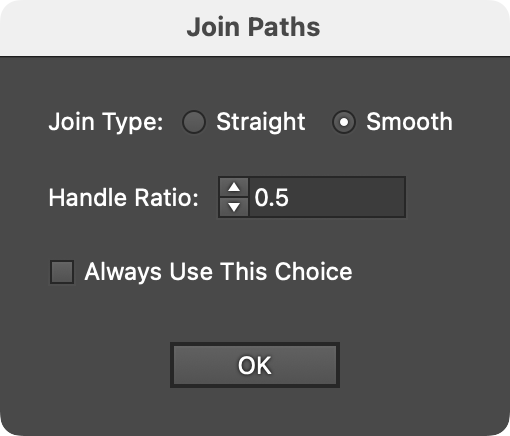
PathScribe Modify Native Join Ask Dialog
The Handle Ratio specifies the length of the automatically-generated handles, in relation to a default value. Higher ratio values will create longer handles, which make the joining curves “protrude” more. The ratio can be specified from 0.1 to 25.
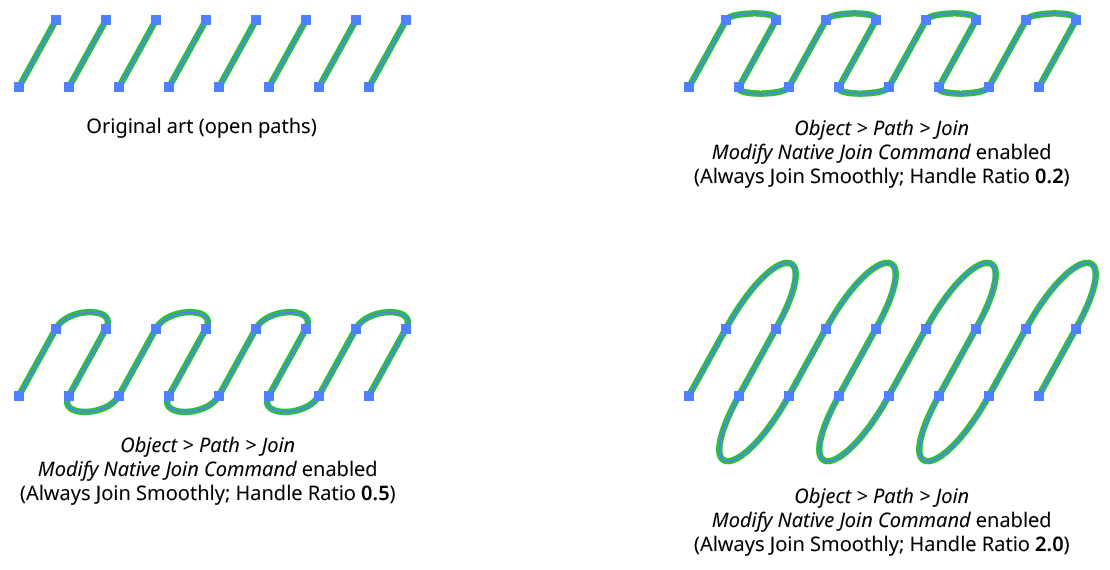
PathScribe Modify Native Join Command Handle Ratio
Note that the native Join command will not convert multiple open paths into a single closed path with a single use; it must be called twice to do this.
15. Add Points to Selected Segments...
Performs the identical function as the Add Points to Selected Segments Button on the PathScribe panel, but is accessible even when the third row of panel buttons is hidden.
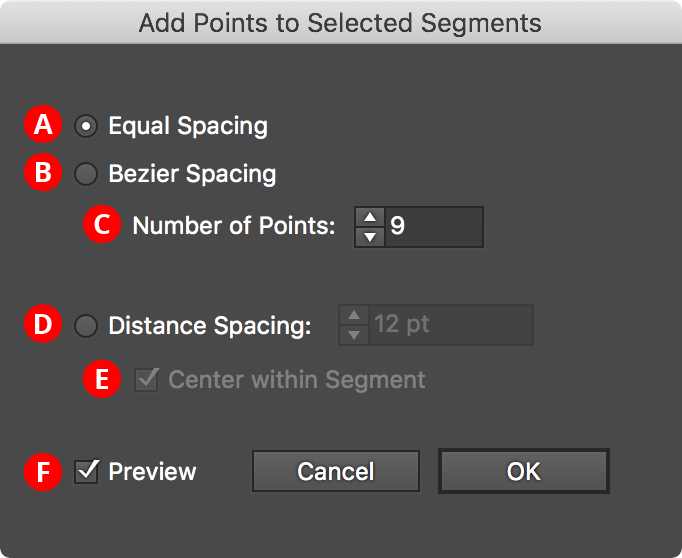
PathScribe Add points to selected segments
There are three different spacing methods you can use to add points. For the first two, Equal Spacing and Bezier Spacing, you specify the number of points to add to each selected segment. Equal Spacing creates equal distances between points, as measured along the path. Bezier Spacing places the points such that there are equal distances between t-values, which are a mathematical property of the cubic bezier curves with which Illustrator’s paths are constructed:

PathScribe Panel Add Point Equal Spacing
For Distance Spacing, you specify the distance between anchor points, as measured along the path. Since this distance will usually not exactly divide the total length of the segment, the “Center within Segment” option allows you to center the new points within each segment:
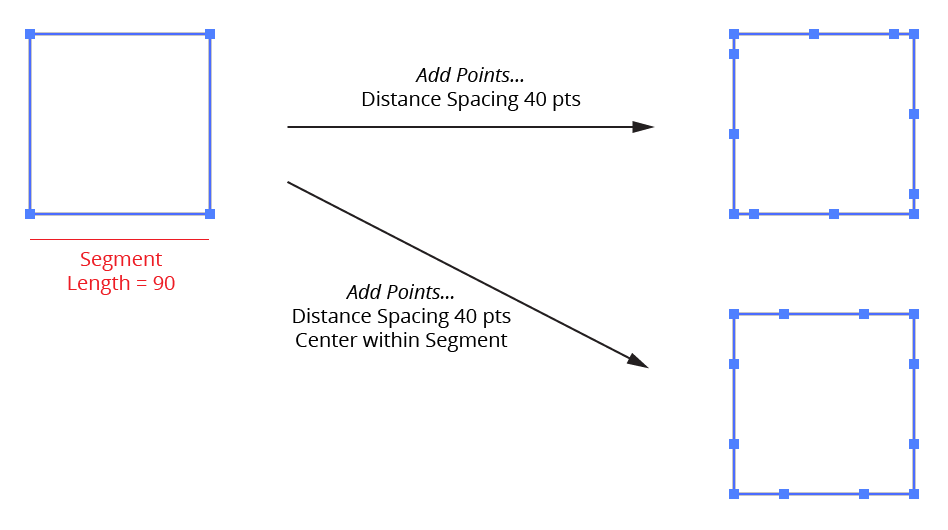
PathScribe Panel Add Points Distance Spacing
You can bypass the dialog and use the values from the previous application of Set Point Selection by holding down Shift while choosing the menu item.
16. Tangencies submenu
Tangencies are places along a path where the path’s direction (and therefore the direction of a line that is tangent to the path at that spot) is either vertical or horizontal (taking into account the general constrain angle). Certain drawing methods include the principle that anchor points along a curved path should be, whenever possible, located at these places of tangency.
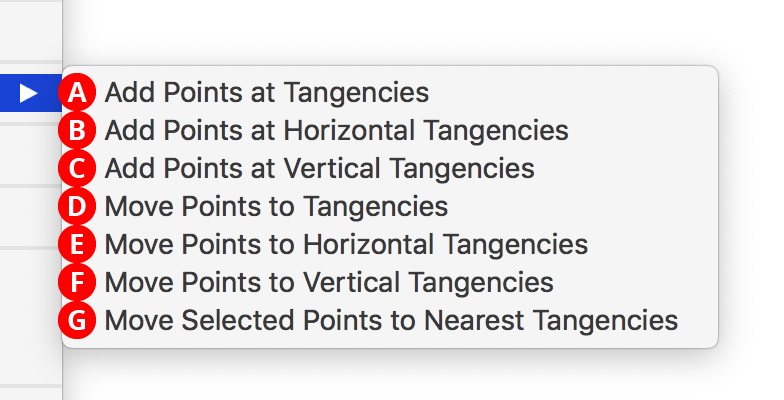
PathScribe Tangencies Flyout Submenu
A. Add Points at Tangencies
B. Add Points at Horizontal Tangencies
C. Add Points at Vertical Tangencies
These menu items add new anchor points, if needed, at places of tangency along all selected paths. Existing anchor points are not changed.

PathScribe Add points at tangencies flyout option
D. Move Points to Tangencies
E. Move Points to Horizontal Tangencies
F. Move Points to Vertical Tangencies
These menu items act similarly to their “Add Points...” counterparts, except that existing anchor points are removed after the tangent points are added if their removal does not alter the path shape appreciably.

Move points to tangencies PathScribe flyout option
G. Move Selected Points to Nearest Tangencies
While the previous items affect every anchor point on a path, this item only moves points which are selected to the nearest horizontal or vertical tangency (if possible).
17. Detect and Adjust Connector Points
Enabled when the Recognize Connector Points preference is enabled, this menu item scans any selected paths for potential connector points and, if found, adjusts their handles.
18. Delaunay Triangulate...
Brings up a dialog which lets you set parameters for creating a “Delaunay triangulation” (a network of triangles) from the selected artwork.
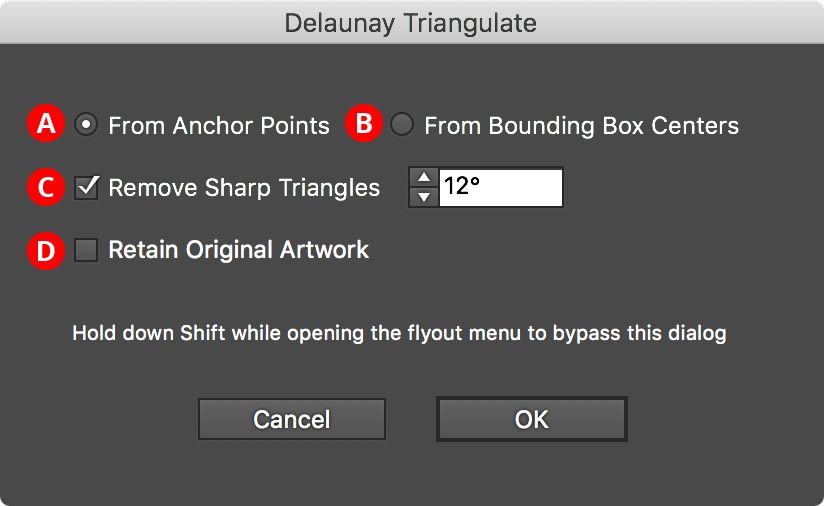
Delaunay Triangulate PathScribe
A. From Anchor Points
Triangles are created using anchor points on all selected paths.
B. From Bounding Box Centers
Triangles are created using the centers of the bounding boxes of all selected art (groups are ignored).
This is useful when creating a triangulation from, say, an expanded Stipple live effect.
C. Remove Sharp Triangles
Delaunay triangulation can create sliver-like triangles that are often undesirable, so this setting lets you eliminate any triangles that have an angle smaller than the threshold value.
D. Retain Original Artwork
When enabled, the artwork used to create the triangles is left in place and the triangles (grouped) are placed above it.
When the Shift key is held down while choosing the menu item, the dialog will not be shown and parameter values that were previously in effect will be used.
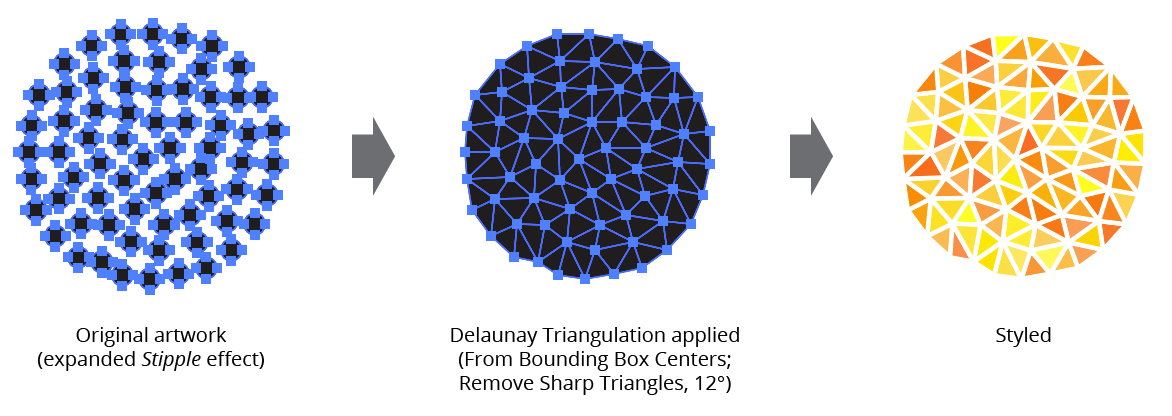
Delaunay Triangulate Points PathScribe
19. Extract Dashes
Converts a path with a dashed stroke into a compound path made up of separate, non-dashed subpaths.
This can be useful for giving the dashes different styles, for example:

PathScribe flyout menu extract dashes
20. Show/Hide Additional Buttons
Shows or hides the third row of buttons on the PathScribe panel. When hidden, most of the buttons’ functionality can still be accessed through the flyout menu commands.
21. Show/Hide Numeric Value Fields
Shows or hides the center section of the PathScribe panel which shows anchor point and handle coordinates.
22. Show/Hide Path Control Area
Shows or hides the bottom Path Control area of the PathScribe panel.
23. Reset Tip Dialogs
If the “Don’t show again” checkbox was used on any tip dialogs (such as the AutoGlue dialog that appears when the feature is enabled), this resets the dialogs so they are shown again.
24. PathScribe Preferences...
Brings up the Preferences dialog.
